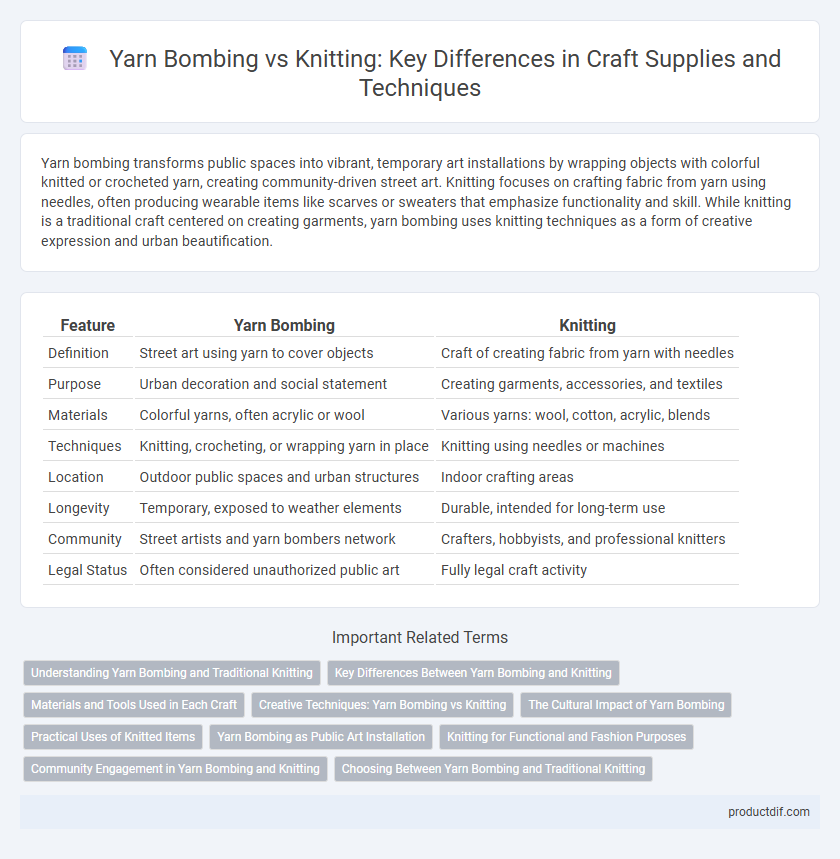Yarn bombing transforms public spaces into vibrant, temporary art installations by wrapping objects with colorful knitted or crocheted yarn, creating community-driven street art. Knitting focuses on crafting fabric from yarn using needles, often producing wearable items like scarves or sweaters that emphasize functionality and skill. While knitting is a traditional craft centered on creating garments, yarn bombing uses knitting techniques as a form of creative expression and urban beautification.
Table of Comparison
| Feature | Yarn Bombing | Knitting |
|---|---|---|
| Definition | Street art using yarn to cover objects | Craft of creating fabric from yarn with needles |
| Purpose | Urban decoration and social statement | Creating garments, accessories, and textiles |
| Materials | Colorful yarns, often acrylic or wool | Various yarns: wool, cotton, acrylic, blends |
| Techniques | Knitting, crocheting, or wrapping yarn in place | Knitting using needles or machines |
| Location | Outdoor public spaces and urban structures | Indoor crafting areas |
| Longevity | Temporary, exposed to weather elements | Durable, intended for long-term use |
| Community | Street artists and yarn bombers network | Crafters, hobbyists, and professional knitters |
| Legal Status | Often considered unauthorized public art | Fully legal craft activity |
Understanding Yarn Bombing and Traditional Knitting
Yarn bombing involves decorating public spaces with colorful knitted or crocheted creations, transforming urban environments through street art that blends crafting with activism. Traditional knitting focuses on creating functional items like clothing or accessories using yarn and needles in a structured, methodical approach. Understanding yarn bombing highlights its artistic, communal impact, while traditional knitting emphasizes skill development and practical use.
Key Differences Between Yarn Bombing and Knitting
Yarn bombing is a form of street art that involves covering public objects with knitted or crocheted fabric for decorative or social purposes, while knitting is the traditional handcraft technique of creating fabric from yarn using needles. Yarn bombing emphasizes public spaces and artistic expression, often temporary and guerrilla-style, whereas knitting focuses on producing wearable or functional items like clothing and accessories. The key difference lies in intent and application: yarn bombing transforms urban environments for visual impact, whereas knitting centers on craftsmanship and personal use.
Materials and Tools Used in Each Craft
Yarn bombing primarily uses brightly colored yarns and basic knitting needles or crochet hooks, emphasizing quick, large-scale outdoor installations with materials designed to withstand weather conditions. In contrast, knitting as a craft employs a wider range of yarn types, including wool, cotton, and synthetic blends, alongside specialized tools such as various needle sizes, stitch markers, and row counters to create detailed garments or accessories. Both crafts rely on yarn and needles but differ significantly in material durability and the complexity of tools used for their distinct purposes.
Creative Techniques: Yarn Bombing vs Knitting
Yarn bombing transforms urban spaces into vibrant art installations by wrapping public objects with colorful yarn, utilizing graffiti-inspired techniques that emphasize spontaneity and large-scale impact. Knitting, in contrast, involves methodical interlocking of loops using needles to create wearable textiles or intricate decorative pieces, highlighting precision and pattern complexity. Both creative techniques showcase versatility in fiber arts, with yarn bombing emphasizing public engagement and knitting focusing on craftsmanship and functional artistry.
The Cultural Impact of Yarn Bombing
Yarn bombing transforms traditional knitting into a vibrant form of public art that challenges the boundaries of conventional graffiti and urban expression. This craft supply movement fosters community engagement and cultural dialogue by adorning public spaces with colorful, tactile creations that celebrate creativity and inclusivity. The cultural impact of yarn bombing lies in its ability to reclaim spaces, promote sustainability through upcycled yarn, and inspire a sense of belonging among diverse groups.
Practical Uses of Knitted Items
Knitting produces durable, functional items such as scarves, sweaters, and blankets that provide warmth and comfort for everyday use. Yarn bombing, a form of street art, focuses on decorative and temporary installations that add color and texture to public spaces without practical utility. Practical knitted items serve a utilitarian purpose, enhancing wardrobe and home goods, while yarn bombing emphasizes creativity and community engagement.
Yarn Bombing as Public Art Installation
Yarn bombing transforms public spaces into vibrant galleries, using knitted or crocheted yarn pieces to create temporary street art that challenges traditional graffiti by adding color and texture. Unlike knitting focused on crafting wearable items, yarn bombing emphasizes community engagement and visual impact, often sparking conversations around urban beautification and creativity. This form of public art installation fosters a unique blend of artistry and activism, highlighting the versatility of yarn beyond functional purposes.
Knitting for Functional and Fashion Purposes
Knitting serves both functional and fashion purposes by creating versatile garments, accessories, and home decor items that combine comfort and style. Unlike yarn bombing, which is primarily a form of street art using knitted or crocheted pieces to decorate public spaces, knitting focuses on producing wearable, durable products such as sweaters, scarves, and hats. Advances in yarn technology, including moisture-wicking and sustainable fibers, enhance knitting's appeal for practical use and fashion innovation.
Community Engagement in Yarn Bombing and Knitting
Yarn bombing fosters vibrant community engagement by transforming public spaces with colorful, collaborative textile art that invites participation and sparks local pride. Knitting, often practiced individually or in small groups, builds close-knit social connections through shared craft sessions, enhancing interpersonal bonds and skill exchange. Both crafts contribute to community empowerment, with yarn bombing emphasizing public interaction and knitting supporting intimate communal creativity.
Choosing Between Yarn Bombing and Traditional Knitting
Yarn bombing offers a vibrant, street-level form of artistic expression that transforms public spaces with colorful, unconventional knit or crochet installations. Traditional knitting emphasizes creating functional and wearable items like scarves, sweaters, and blankets through time-honored, methodical techniques. Choosing between yarn bombing and traditional knitting depends on whether the goal is community engagement and outdoor art or crafting personalized, practical garments and accessories.
Yarn bombing vs Knitting Infographic

 productdif.com
productdif.com